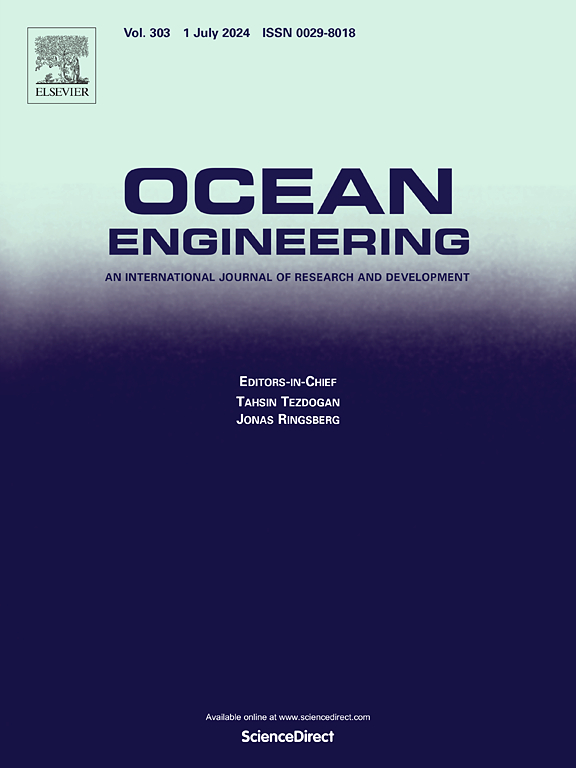Research on dynamic characteristics of a tension-leg modular floating structure system under tendon failure
IF 4.6
2区 工程技术
Q1 ENGINEERING, CIVIL
引用次数: 0
Abstract
Tension-leg modular floating structures (MFS) offer a promising solution for scalable ocean space utilization. However, these platforms may face potential tendon failure during operation, which can lead to severe instability. In this paper, a numerical framework is established to investigate the dynamic characteristics of a tension-leg modular floating structure system under tendon failure, using the ANSYS-AQWA user_force subroutine written in Fortran. Based on this foundation, a systematic analysis was conducted to examine the effects of single tendon failure and progressive tendon failures on motion responses, residual tendon loads, and connector loads under still water, regular waves, and irregular waves. The results indicate that tendon failure leads to adjustments in the modules' attitude and oscillations around a new equilibrium position, while its impact on the overall motion response remains relatively limited. Following the tendon failure, the residual tendon loads of the affected module increase significantly, and the connector loads between the affected and adjacent tension-leg modules are also considerably amplified. Due to the mechanical coupling effect of the connectors, the effect of tendon failure gradually propagates to other modules, causing minor transient responses and redistribution of tendon loads throughout the system, though the overall impact remains relatively small. In addition, an active ballast tank control strategy is proposed, which injects ballast water at the failed tendon location to adjust the module attitude and effectively mitigate the adverse dynamic responses caused by tendon failure. The results of this work provide valuable references for the design, operation, and failure prevention of tension-leg modular floating structures.
张力腿模块化浮式结构系统在肌腱破坏下的动力特性研究
张力腿模块化浮动结构(MFS)为可扩展的海洋空间利用提供了一个有前途的解决方案。然而,这些平台在操作过程中可能面临潜在的肌腱断裂,这可能导致严重的不稳定。本文利用用Fortran语言编写的ANSYS-AQWA user_force子程序,建立了一个数值框架,研究了张力腿模块化浮式结构系统在肌腱破坏下的动力特性。在此基础上,系统分析了静水、规则波和不规则波下,单肌腱破坏和渐进肌腱破坏对运动响应、残余肌腱载荷和连接件载荷的影响。结果表明,肌腱破坏导致模块姿态的调整和围绕新的平衡位置的振荡,而其对整体运动响应的影响仍然相对有限。肌腱破坏后,受影响模块的残余肌腱载荷显著增加,受影响模块与相邻张力腿模块之间的连接器载荷也显著放大。由于连接件的力学耦合效应,肌腱破坏的影响逐渐传播到其他模块,在整个系统中引起较小的瞬态响应和肌腱载荷的重新分配,尽管总体影响仍然相对较小。此外,提出了一种主动压载水舱控制策略,通过在失效肌腱位置注入压载水来调节模块姿态,有效缓解肌腱失效引起的不良动力响应。研究结果为张腿式模块化浮式结构的设计、运行和失效预防提供了有价值的参考。
本文章由计算机程序翻译,如有差异,请以英文原文为准。
求助全文
约1分钟内获得全文
求助全文
来源期刊

Ocean Engineering
工程技术-工程:大洋
CiteScore
7.30
自引率
34.00%
发文量
2379
审稿时长
8.1 months
期刊介绍:
Ocean Engineering provides a medium for the publication of original research and development work in the field of ocean engineering. Ocean Engineering seeks papers in the following topics.
 求助内容:
求助内容: 应助结果提醒方式:
应助结果提醒方式:


